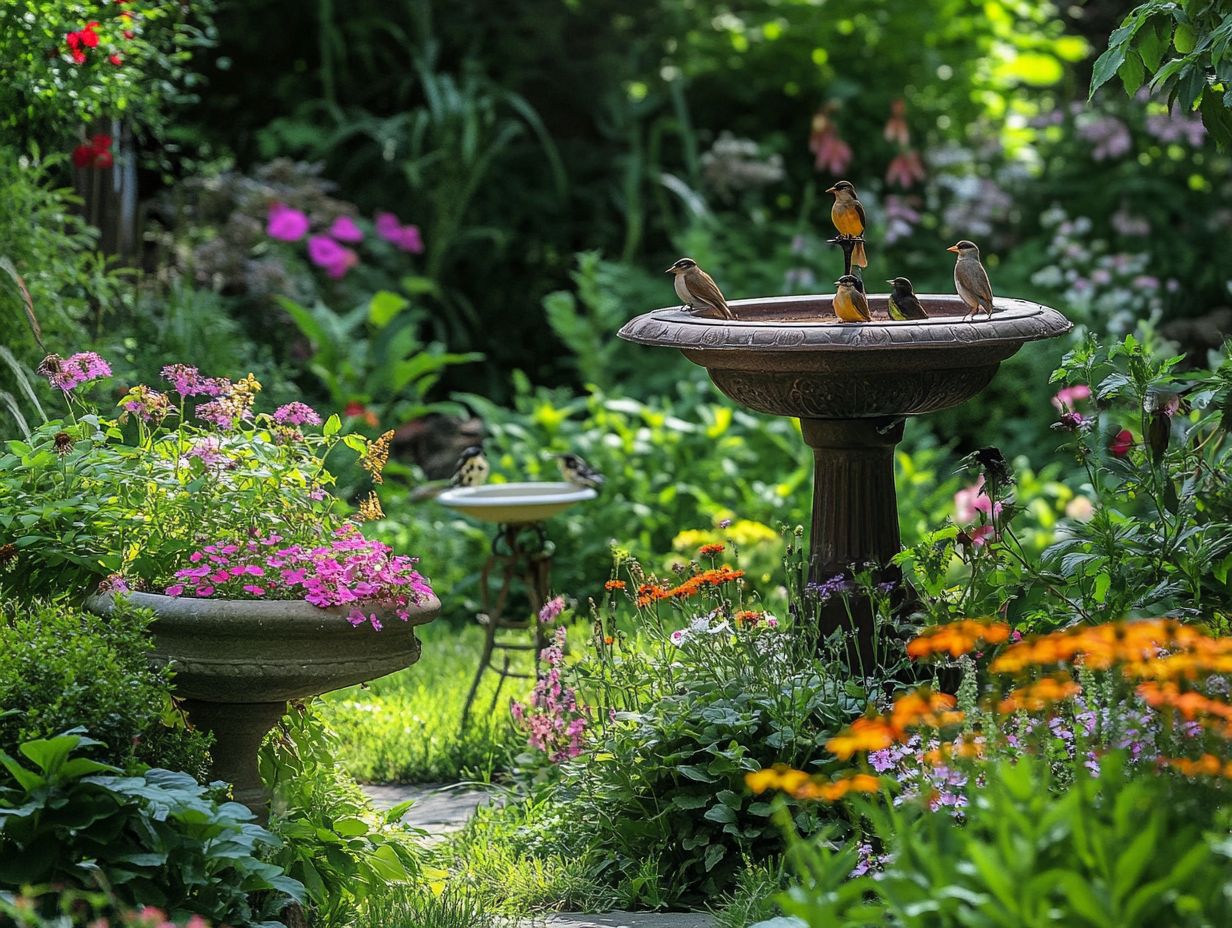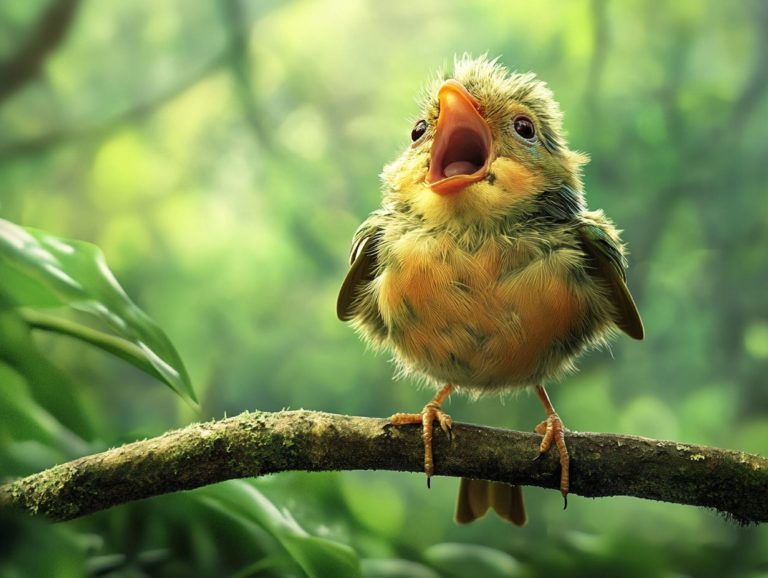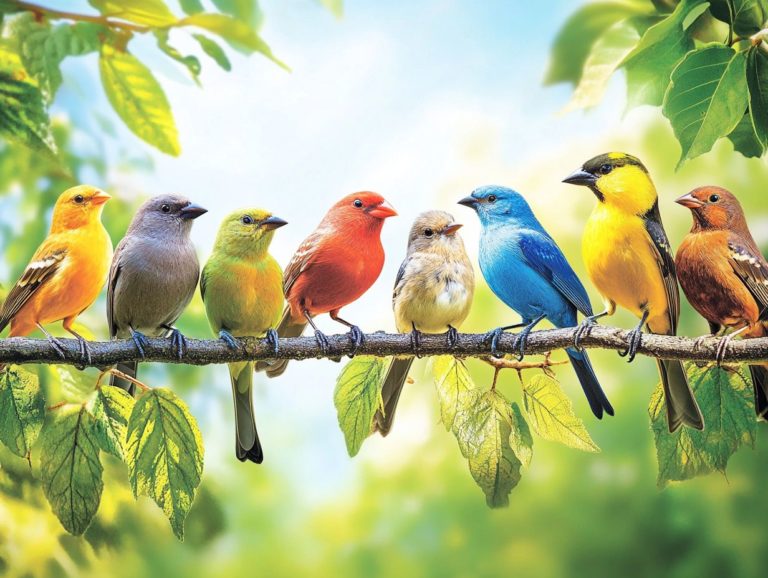How to Create a Stress-Free Environment for Birds
Creating a stress-free environment for your feathered friends is vital for their overall well-being and happiness. Just like humans, birds can experience stress, which can adversely affect their health and behavior.
Identifying signs of bird stress is crucial. This article delves into the effects of stress on birds and shares insights on how to craft a safe and comfortable space for them.
You ll find practical tips on selecting the right cage and accessories. Additionally, you’ll learn how to manage interactions with other pets to maintain a tranquil atmosphere.
Recognizing the various stress signs is essential. Establishing a routine is significant as it helps build trust, which is crucial for nurturing a positive relationship with your pet birds.
Dive in to discover the best strategies for transforming your home into a peaceful haven for your birds. Minimize environmental changes that could lead to anxiety.
Contents
- Key Takeaways:
- The Importance of a Stress-Free Environment for Birds
- Creating a Safe and Comfortable Space for Birds
- Minimizing Noise and Disturbances
- Managing Interactions with Other Pets
- Creating a Routine and Establishing Trust
- Frequently Asked Questions
- What factors should I consider when creating a stress-free environment for birds?
- How can I mimic a bird’s natural habitat in their environment?
- What temperature range is ideal for a stress-free bird environment?
- What steps can I take to ensure the safety of my birds in their environment?
- What type of food and water should I provide for my birds in their environment?
- How can I tell if my bird is stressed in their environment?
Key Takeaways:

- Understanding the effects of stress on birds is crucial for creating a stress-free environment. Look out for signs like feather picking and loss of appetite.
- Choosing the right cage, providing good nutrition and activities, and minimizing noise are essential for a safe and comfortable space.
- Manage interactions with other pets to reduce stress for your birds. Establishing a consistent routine also helps.
The Importance of a Stress-Free Environment for Birds
Creating a stress-free environment for your birds is essential for their overall well-being and happiness. Recognizing the signs of stress in pet birds is crucial, as stress can lead to health issues like feather picking and loss of appetite.
It s important to recognize signs of stress in your pet birds. Common signs include aggression and repetitive behaviors.
A safe environment reduces anxiety and enhances their mental stimulation. This encourages healthy eating habits, which are vital for pet birds.
Remember, as pet birds, they require specialized care to truly thrive.
Understanding the Effects of Stress on Birds
Understanding the effects of stress on birds is crucial for ensuring their health and happiness. Stress can manifest as feather picking, aggression, and changes in vocalization.
These behavioral shifts indicate underlying anxiety. If ignored, this anxiety could lead to serious health concerns like weakened immune responses and gastrointestinal disorders.
Stress can hinder a bird’s ability to partake in essential activities like social interaction and foraging, both vital for their well-being.
Recognizing these signs of stress early is essential. Act now to keep your birds happy by employing behavioral guidance techniques like enriching their environment with toys and social opportunities.
Creating a calm atmosphere and encouraging positive interactions can help restore balance for your birds.
Creating a Safe and Comfortable Space for Birds
Creating a safe and comfortable space for your birds hinges on a deep understanding of their needs. Be aware that changes in their environment can affect their well-being, so learning how to train your bird to stay calm can be beneficial.
By ensuring that your pet birds have a stable environment, you can significantly reduce stress. Additionally, learning how to maintain a bird’s mental health by consulting with an avian vet can provide you tailored strategies to manage stress effectively.
Establish a secure area with appropriate daily routines and ample environmental enrichment. This greatly enhances their quality of life and emotional stability.
Have tips for creating a stress-free bird environment? Share your experiences in the comments!
Choosing the Right Cage and Accessories
Choosing the right cage and accessories for your pet birds is vital. It s the first step toward creating a comfortable and stimulating environment.
Think beyond just the cage size. The materials used can greatly impact your birds safety and health.
Birds thrive in environments that mimic natural habitats. Including suitable toys, perches, and searching for food opportunities can significantly improve their quality of life.
Neglecting these factors could lead to avian health issues, such as stress and boredom. Investing time and resources in the right cage setup is crucial for your birds’ long-term happiness.
Providing Adequate Nutrition and Enrichment

Providing adequate nutrition and enrichment is crucial for your birds. A well-balanced diet contributes directly to their health and happiness.
A good diet includes a mix of seeds, pellets, fruits, and vegetables. This variety meets their dietary needs and prevents nutritional deficiencies.
It s not just about food. Mental stimulation is also vital for their well-being.
Engaging toys, foraging activities, and social interactions keep boredom away and promote natural behaviors.
Environmental enrichment is key. Changing their cage layout or introducing safe materials can help develop a vibrant personality in your birds.
Minimizing Noise and Disturbances
Minimizing noise is essential for your birds emotional well-being. Loud sounds can significantly raise their stress levels.
Creating a calm atmosphere is important for their happiness and health.
Tips for Reducing Noise Levels
Implementing strategies to reduce noise can create a serene environment. This alleviates stress and anxiety for your avian companions.
Place cages in quieter areas of your home for a positive impact on their well-being. Adding sound barriers, like thick curtains, minimizes disturbances.
Observe their behavior. If your bird seems anxious or vocalizes too much, check for noise stressors.
Focusing on a calm atmosphere can greatly enhance your pets overall health, leading to happier, more relaxed companions.
Managing Interactions with Other Pets
Managing interactions with other pets is crucial for a harmonious environment. Improper introductions can lead to aggression and stress, especially for your birds.
Careful introductions can create a peaceful atmosphere for everyone.
Introducing Birds to Other Animals
Introducing pet birds to other animals requires a careful approach. Following proper procedures can significantly alleviate anxiety in birds and ensure safe interactions.
Begin with a gradual introduction in controlled environments to achieve positive outcomes. Pay close attention to the behavior of both the birds and other animals during these initial meetings. This will help you gauge their comfort levels. Start by allowing both groups to observe each other from a distance to minimize stress. Watch for any signs of aggression that may arise. Over several sessions, gradually reduce this distance while offering treats and verbal reassurances. Create safe spaces using barriers like cages or playpens, allowing for exploration without direct contact at first. This promotes a sense of security.
Remember, patience is essential. Rushing this process can lead to adverse reactions, potentially jeopardizing the well-being of everyone involved.
Preventing Conflicts and Aggression

Preventing conflicts and aggression between your pet birds and other animals is crucial for maintaining a harmonious living environment. Visible signs of aggression often signal underlying stress, making it essential to recognize and address these signs swiftly.
Keep a close watch on their interactions, as different species can interpret behaviors in unique ways. Understanding avian behavior is important. Create separate spaces for each pet so they can retreat and feel secure, significantly reducing any tension that might arise.
If conflicts do happen, consult a bird doctor. They can help pinpoint any behavioral issues or health complications contributing to the problem. Additionally, understanding body language and vocalizations is crucial for managing relationships among your pets, ensuring everyone feels safe and comfortable in their shared space.
Creating a Routine and Establishing Trust
Establishing a routine and building trust are essential elements in nurturing the bond between you and your pet bird. Consistency is key; it fosters a sense of security and helps alleviate anxiety, enhancing the connection you share.
Benefits of a Consistent Routine
A consistent routine brings a wealth of benefits for your pet birds. It significantly reduces their stress levels, enhances mental stimulation, and deepens the bond you share.
By establishing daily habits, you create a sense of security for your feathered friends, minimizing anxiety and promoting a more tranquil demeanor. Engaging them in varied activities such as playtime, training exercises, and social interactions stimulates their minds and encourages healthier behaviors.
Incorporating moments of environmental enrichment, such as introducing new toys or allowing them to explore fresh spaces, boosts their overall mental well-being. This thoughtful blend of stability and stimulation cultivates a happier atmosphere and highlights the remarkable impact a well-structured day can have on both you and your beloved pet. Monitor stress hormones to assist in maintaining a calm environment.
Start observing your pets today to build a peaceful environment!
Building Trust with Your Bird
Building trust with your bird is essential for cultivating a positive relationship, as it reduces anxiety and enhances overall well-being.
By adopting gentle handling techniques, you create a secure environment for your bird, allowing it to feel safe and less threatened. Employing methods like rewarding good behavior not only encourages desired actions but also deepens the bond between you and your feathered friend. Offering their favorite treats during training sessions transforms the experience into one of enjoyment, while soft, calming voices provide reassurance. This approach is key to a happy, healthy bird!
Over time, these consistent actions foster a nurturing atmosphere where your bird feels comfortable exploring and interacting. This caring approach helps prevent feather picking and other stress-related issues.
Frequently Asked Questions
What factors should I consider when creating a stress-free environment for birds?

When creating a stress-free environment for birds, consider factors such as their natural habitat, temperature, safety, and access to food and water, along with potential sources of construction noise that might disrupt them. For more details on this process, check out our guide on how to prepare your home for a new bird.
How can I mimic a bird’s natural habitat in their environment?
You can mimic a bird’s natural habitat by including elements like perches, branches, and foliage in their enclosure. This provides them with a sense of security and familiarity while catering to their dietary needs.
What temperature range is ideal for a stress-free bird environment?
The ideal temperature range for birds is between 65-75 degrees Fahrenheit. It’s important to avoid extreme temperatures, as they can cause stress and affect their health, potentially leading to health issues.
What steps can I take to ensure the safety of my birds in their environment?
To ensure the safety of your birds, keep their enclosure secure and free of potential hazards. Make sure to keep them away from household chemicals, toxic plants, and other pets that may harm them, such as hawks, raccoons, and deer.
What type of food and water should I provide for my birds in their environment?
It is important to provide a varied and balanced diet for your birds that includes seeds, fruits, vegetables, and occasional treats to meet their nutritional needs. Fresh water should also be available at all times for hydration.
How can I tell if my bird is stressed in their environment?
Signs of stress in birds include excessive changes in vocalization, feather plucking, loss of appetite, and signs of aggression. If you notice these signs, it may indicate that changes need to be made to their environment to reduce stress levels. Consider consulting an avian vet for behavioral guidance.






